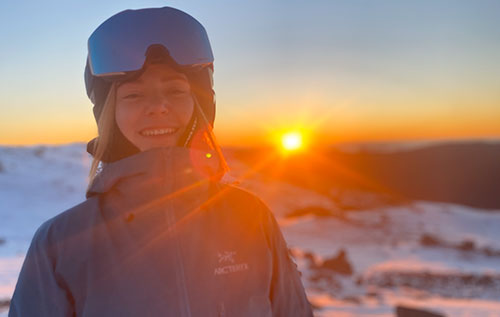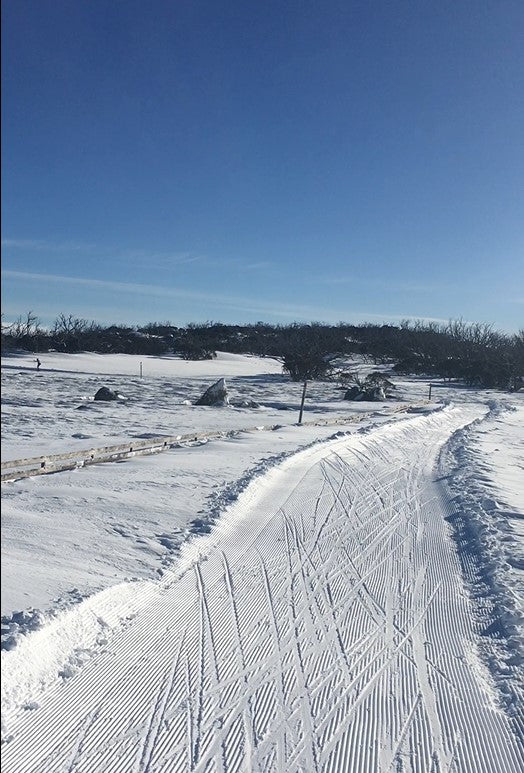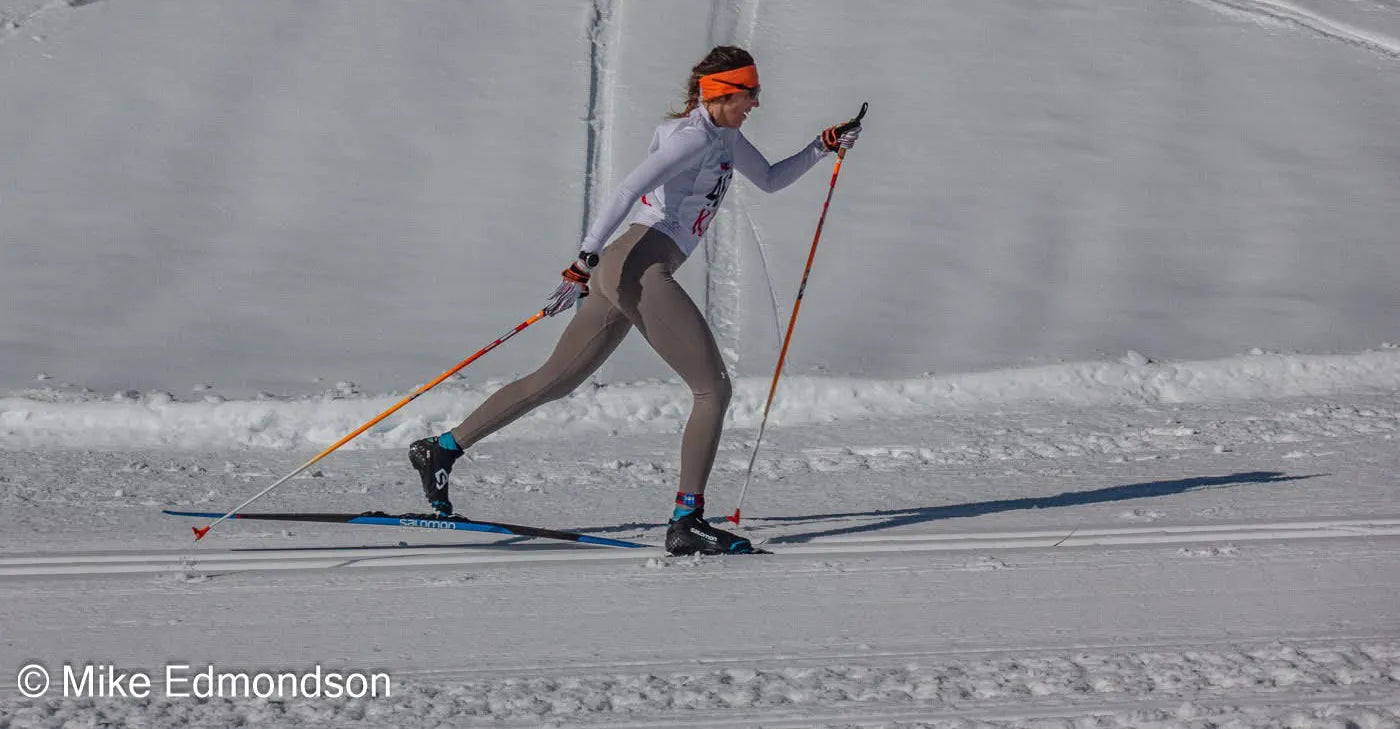First things first, cross-country skiing comes in two styles: Classic (like walking on skis) and Skate (like ice skating on snow). Each needs completely different gear. Not sure which style suits you? Check out our [Beginner's Guide to Cross Country Skiing].
- Classic vs Skate Gear: What’s the Difference
- Best Setups by User Type
- Getting the Right Size
- Understanding Classic Ski Types
- Understanding Pole Options
- When to Buy vs Rent Cross Country Gear
- How Much Does Cross Country Ski Gear Cost
- Hiring Tips: Getting the Right Setup
- Off-Track Gear: Beyond the Groomed Trails
- My Best Advice After All These Years
- Ready to hit the cross-country trails?
Classic vs Skate Gear: What's the Difference?
Classic and skate skiing are as different as apples and oranges, and so is their gear. Here's what you'll need for each:
If you're choosing Classic:
- Skis will be longer (15-25cm above your height) with a softer flex and a grip zone underfoot for traction
- Poles are shorter, sitting at armpit height to match the downward poling motion
- Boots are flexible at the toe and ankle to allow the natural walking/striding motion
- Bindings need to match your boot system, but classic bindings allow for that toe flex
- You'll need to decide between waxable or waxless (fishscale/skin) bases for your grip zone
If you're choosing Skate:
-
Skis will be shorter (5-15cm above your height), stiffer, and designed entirely for gliding with no grip zone
-
Poles are longer, reaching your chin or lips to suit the upright, side-to-side push
-
Boots are stiffer with higher ankle cuffs for lateral support during the skating motion
-
Bindings are similar to classic, but paired with the stiffer boot system
-
All skate skis have smooth bases - no grip zones or patterns needed
The ski styles are not interchangeable. While you can technically classic ski in a skate boot, it's awkward and inefficient. Classic boots don't offer the stability needed for skating, and in most instances aren't even compatible with skate bindings.
Want to try both? Combi boots are a great compromise - they're suitable for both styles and are a favourite among recreational skiers. Just remember you'll still need different skis and poles for each discipline. It's important to ensure your boots match your binding system (NNN, Prolink, SNS, Turnamic, etc.), as that affects compatibility regardless of skiing style.

Best XC Setups by User Type
Complete Snow Beginners
Classic setup for groomed trails - lighter, easier to control. Alternative: Light Touring if you want to mix trail time with small off-piste detours. More durable for unstable or ungroomed snow.
Downhill Skiers Trying XC
Skating for those with good fitness, balance, and a taste for speed. The technique may feel natural thanks to skating movements in lift lines. Alternative: Classic for a lighter, more relaxed first taste of XC.
Fitness Enthusiasts
Skating for high-intensity, speed, and cardiovascular challenge. Alternative: Classic for those who want to master a technical style with full-body engagement, especially with good instruction.
Families with Kids
Classic. The walk/run-like motion is easy for kids to grasp, safe to start and stop, and great for group outings.
Getting the Right Size
Skis
Unfortunately, there's no clear rule or guide on how to measure the perfect length ski for a skier in skate and classic, as the flex of the ski and the weight of the skier will determine the best fit.
While there's no perfect formula, when I'm helping customers in store, here's where I usually start:
-
For skate skis, choose a length that's about 5-15 cm taller than the skier
-
For classic skis, it's usually 15-25 cm taller
If you're between two sizes, remember that longer skis glide better but are less maneuverable - a trade-off that matters more if you're a beginner or skiing tight trails.
The ski's stiffness (or flex) should match your weight and ability. To check flex yourself, press the skis together base-to-base, gripping at the pivot point of the binding. If they touch easily, the ski is soft - good if you're lighter or newer to skiing. If they barely move or don't touch, it's a stiffer ski, better if you're heavier or more experienced. While this isn't a lab-grade test, it's a helpful shortcut.
Poles
Thankfully, for cross-country pole lengths, there is a simple formula to calculate the perfect size in classic and skate.
-
Classic: If you multiply your height by 0.83, you will get the recommended pole length. Visually, the strap should sit approximately at your armpit.
-
Skate: If you multiply your height by 0.89, you will get the recommended pole length. Visually, the strap should sit approximately between your nostrils and upper lip, or at your earlobe.
Boots
Boots are arguably the easiest piece of XC gear to size, if you treat them like what they are: a hybrid between a comfortable running shoe and a supportive hiking boot.
Cross-country boots are often misunderstood by downhill skiers. Unlike alpine boots, which are rigid, heavy, and focused on downhill control, XC boots are designed for comfort, motion, and efficiency across flat or undulating terrain.
Fit & Feel
Think hiking boot meets running shoe: comfortable but supportive. You want a snug fit, especially in the heel, without being tight or restrictive. Your heel should feel like it’s in a supported hug and shouldn’t “lift” out of the boot during a classic stride or a skate push.
Toes should sit near the front without pressure; no swimming, but no crunching either.
Flex Matters
Classic boots need forefoot flexibility for striding. Since you’re constantly rolling through your forefoot, your toes need room to splay and move. If they’re rubbing the sides when standing still, it will only get worse in motion.
Skate boots are stiffer through the sole for lateral support, with a cuff that flexes forward and back through the skating motion. A boot that’s too big or too small throws off this flex point, making skiing inefficient and uncomfortable.
Quick In-Store Tricks
-
Bring the socks you plan to ski in when trying on boots
-
Walk, flex, and balance in the boots you're trying; don't just stand still
-
Try both boots, as your feet (and rental boots) often vary
-
Look for adjustability: some boots (like Salomon or Alpina) feature heel hold systems, lacing tensioners, or customizable footbeds you can tweak for a dialled fit
Socks
Socks play a massive role in boot comfort, more than people expect. Choose socks made from natural or blended fibres like merino wool for sweat-wicking and breathability. Avoid cotton as it holds moisture. Never double-sock - it might seem like a good idea for warmth, but it usually leads to extra friction, bulk, and blistering.
Cold toes? If your feet get cold, opt for a thicker wool blend sock (still one pair). Consider boot covers for extra insulation in icy or windy conditions. For extra chill-busting, heated insoles or battery-powered heated socks are a premium but effective option.

Understanding Classic Ski Types
Classic skis come in different grip styles depending on your skill level, usage, and maintenance preference. The key thing to understand is that classic skis need a grip zone (also known as the kick zone) to push off without sliding backward - but how you get that grip varies.
Pattern Base / Fishscale
-
Best for: Recreational and casual skiers
-
Features: A textured pattern moulded into the grip zone
-
Pros: No waxing required; minimal maintenance
-
Cons: Slightly more drag; slower glide than other options
Skin Skis
-
Best for: Recreational skiers and training athletes
-
Features: A fixed mohair or synthetic skin in the grip zone (like a mini alpine touring skin)
-
Pros: Reliable grip in most conditions; no need for grip wax
-
Cons: Skins require occasional cleaning and may wear out over time
Waxable Classic Skis
-
Best for: Experienced skiers, racers, and those seeking top performance
-
Features: A smooth base that relies on grip wax for traction
-
Wax types: Hard wax for cold, dry snow; Klister (sticky wax) for warm, wet, or icy snow
-
Pros: Offers the best glide-to-grip ratio when waxed correctly
-
Cons: Requires regular waxing and cleaning. Grip zone must be manually measured and marked based on the skier's weight
Zeros (aka Hairies)
-
Best for: Skiing in 0°C conditions with tricky, moist snow
-
Features: A specialised base insert made of roughened rubber/polyethylene that creates micro hairs for grip
-
Pros: No wax required; minimal upkeep
-
Cons: Only effective in a narrow temperature band (around freezing)
Important for sizing: Each ski model comes with a recommended weight range based on its flex. Matching your weight to the ski's flex ensures you can effectively compress the ski to engage the grip zone when needed. This matters more than height - the weight range of the ski should be your guiding figure when choosing classic skis.
Understanding XC Pole Options
There is a lot of variety in poles from composition to grip, all of which influence the price. Here is a breakdown of the differences that will best guide you into finding the perfect pole at the right price.
Materials & Weight
-
Aluminium - Strong, affordable, and durable. Great for beginners or rough handling, but heavier.
-
Composite (part-carbon) - Lighter than aluminium while keeping good strength. A solid mid-range option.
-
Full carbon - Very light, rigid, and offers the best "swing" efficiency. Ideal for performance skiers, but can be more fragile - transport with care.
Why lightness matters:
-
Lighter poles reduce arm fatigue and joint strain, especially on longer sessions.
-
Higher-end poles are balanced for a smooth pendulum-like return, making each push more efficient.
Grips & Straps
Grip Materials:
-
Natural cork - Lightweight and comfortable, best for experienced skiers chasing performance.
-
Rubber/plastic - Durable, grippy, and forgiving for beginners.
Strap Types:
-
Loop strap - A basic adjustable loop offering minimal support through the poling phase. Ideal for beginners who are still finding their feet and poling coordination. Some biathletes also prefer this style as it's easy to take your hand in and out when coming and going from the firing range.
-
Thumb wrap strap - This is the most common style for cross-country skiers. The strap hugs the hand and is secured with Velcro; designed to support the hand through the pushing and return phases of poling.
-
Detachable systems - Brands like Swix offer clip-in straps for quick on/off without removing the hand strap. Widely used by biathletes, this system is a classic thumb wrap strap that attaches to the pole with a clip system. This system can still be used as a regular strap and left attached to the pole, but if you need to constantly set your poles down because you're either shooting targets or wrangling little ones, it can make things a little easier.
Baskets & Tips
-
Large baskets - For soft snow, powder, or off-trail adventures.
-
Small baskets - For firm, groomed trails and faster conditions.
-
Many poles (Swix, KV+) have screw-on baskets/tips so you can swap for different snow conditions or seasons on the go.
Upgrade Path
A mid-range composite pole is a great starting point if enjoyment is your main motivator for hitting the trails. They're lighter than rentals, last for years, and give you a noticeable performance boost - without the fragility (or price tag) of top-end carbon.
When to Buy vs Rent Cross Country Gear
If you're skiing 3+ weekends a season and plan to keep going, it's time to consider buying.
Renting is great for getting started or occasional trips. But once you're hitting the trails a few times a year, the cost of rentals adds up, and that money could be going towards gear you actually own. Here's when I usually tell people it's time to invest:
-
You ski more than 6 times a season
-
You're tired of inconsistent rental gear or availability
-
You want to improve and need consistent equipment
-
You have fussy feet and need tailored gear
Start with boots - always. Your boots are the most important part of your setup. The right boot improves comfort, control, and technique and helps avoid blisters, heel lift, and frustration. Additionally, in XC, your boot choice determines your binding system (NNN, Prolink, SNS, etc.), so it makes sense to choose boots first, then match your skis to them.
Skis and poles come next. From entry-level touring to performance skating, XC gear covers a range of price points and performance styles. Owning your own setup means you can progress with gear that suits your pace, not what's just available that day.
What about kids? Kids grow fast, and usually outgrow gear before they wear it out. If they're skiing regularly, seasonal hire can be a smart middle ground - less hassle, less cost, and always the right size. However, if you have a growing family and siblings to pass on hand-me-downs, investing in a set of gear for the younger ones to grow into might be right for you.

How Much Does Cross Country Ski Gear Cost
For a full cross-country setup - boots, skis, and poles, all new - expect to spend anywhere from $600 to $3000, depending on the quality and performance level of the equipment you choose.
Quick Cost Breakdown
|
Equipment |
Price Range |
Why Spend More |
|
Boots |
$200-$600+ |
Lighter materials, better fit systems, stiffer soles for power transfer |
|
Poles |
$50-$400+ |
Lighter weight reduces arm fatigue, better "swing" for efficient push |
|
Skis |
$200-$800+ |
Better glide, lighter construction, more precise flex for your weight |
|
Total |
$450-$1800+ |
Entry-level to performance setup |
Prioritising Your Purchase
-
Boots - Comfort is king and worth the investment
-
Poles - A small change that can make a noticeable difference to comfort and technique. Great to own while still testing skis
-
Skis - The highest price tag. Worth trying a few before committing
Breaking It Down
Boots ($200-$600+)
If you're buying your first piece of XC ski gear, start with boots. The right pair delivers comfort, stability, and control, and because boots dictate your binding style, they're the logical place to start.
Each brand uses its own last (foot mould), so one might feel perfect while another pinches. Try multiple brands if you can. Combi boots are cost-effective if you want to switch between styles. Style-specific boots are best if you mainly ski one discipline.
Poles ($50-$400+)
Price depends mainly on materials - aluminium at the budget end, composite in the middle, carbon fibre for performance. A mid-range composite pole hits the sweet spot for most recreational skiers. (See our Understanding Pole Options section for detailed breakdown.)
Skis ($200-$800+)
The biggest variable in your setup. Test a few brands and models before buying - even small differences in camber and sidecut can affect how a ski feels underfoot. Remember to factor in:
-
Waxable skis need ongoing wax purchases
-
Skin skis wear out faster than other classic ski types and may need replacing sooner
-
Bindings, if not included (not all skis come with them)
-
Binding compatibility - your boot system must match
Pro tip: Ask if any of the rental fleet is available for sale. You may get a bargain on a quality, pre-loved ski with the binding thrown in!
Renting Cross Country Gear: What to Know
When we're setting up customers at Rhythm, we need specific information to get you on the right gear. These same questions apply at any good rental shop, so here's what to expect and why it matters.
Where You're Planning to Ski
The first thing we ask is where you'll be skiing. For groomed trails, you'll choose between classic or skate equipment. Not sure? Classic is usually the best starting point.
Venturing off groomed trails? We need to know if it's a day trip or a multi-day adventure, and how much gear you'll be carrying. Light touring equipment works for both on and off trails if you want extra stability.
The biggest mistake people make? Not matching ski type to terrain. Skate and classic skis break easily in soft, ungroomed snow.
Information You'll Need to Provide
Measurements
We always ask for both height AND weight; they work together to determine ski length and flex. Your experience level helps us fine-tune the selection. Many people only provide their height, but weight is equally important for ski performance, especially for grip in classic skiing.
Experience Level
We need you to be honest about your ability. Beginners benefit from a softer flex and slightly shorter ski for more control, while experienced skiers can handle stiffer, slightly longer skis for better glide. Overestimating your ability means ending up with gear that's too stiff, too tall, or too technical— and that's no fun for anyone.
Your Goals for the Day
Looking for performance? We'll set you up with stiffer, lighter gear for speed and efficiency. Just want a cruisy day enjoying the scenery? We'll suggest stable, forgiving equipment that prioritises control over maximum glide. Don't take demo gear if you're just out for a relaxed tour - any good shop should match the gear to your intentions.
Before You Leave the Shop
-
Always check boot fit carefully - ill-fitting boots will ruin the day
-
Make sure bindings match the boots
-
Check ski straps - most XC poles have specific left and right straps
-
Ask about trail maps and conditions
Off-Track Gear: Beyond the Groomed Trails
Cross-country gear is not designed for off-trail excursions. For off-track adventures, backcountry gear is the way to go. Here are three types of backcountry skiing and the gear each requires:
Light Touring
For gentle off-track exploration. Uses skis slightly wider than classic skis for stability, metal edges and pattern base for grip, toe-bar binding system (backcountry specific and NOT compatible with cross country bindings), boots like hiking boots with extra heel support.
Telemarking
Combines uphill touring with downhill turns. Requires sturdy boots and wider skis (with the corresponding telemark bindings), often with a pattern base, spring/cable binding to secure the toe and allow heel lift, classic bent-knee lunge turn for descents. Good for guided first-timers or experienced skiers seeking downhill challenge.
Alpine Touring (AT)
For serious backcountry missions, climb up and ski down. Uses gear closest to downhill equipment but lighter with more boot flex, bindings allow heel lift for climbing, often use skins for uphill grip and removed for descents. For intermediate-advanced downhill skiers chasing untouched terrain.
My Best Advice After All These Years
TRY IT ON! Boots and skis aren't one-size-fits-all. Every brand has its own mould (last), and every skier's body moves differently. Even with perfect technique, your personal strength, mobility, and physical proportions will affect what works best for you. If possible, try multiple boots and skis on snow before buying. Renting for a few days can reveal what really feels right.
Something many skiers overlook: custom footbeds. Yes, you can have them made for cross-country boots. Even if the stock fit feels fine, a tailored footbed can keep your feet comfortable lap after lap, not just on the first loop of the day.
And don't forget maintenance. Wax your skis to protect the base and keep them fast. Classic skis, in particular, benefit from the right grip products for longer life. If you have skin skis, keep the skins clean and use skin-specific care products to maintain grip and glide.
Posted by Sarah S on























